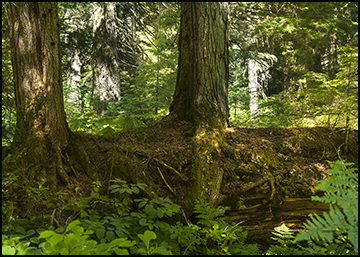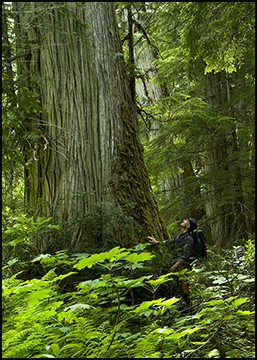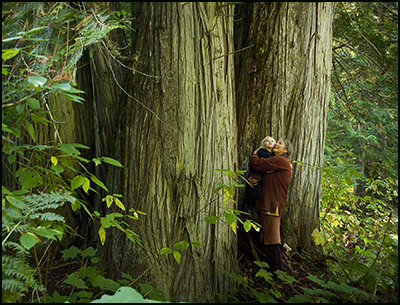 Due to clearcut logging in British Columbia, many valleys have no old-growth left at all. The preservation of the Great Bear Rainforest on the BC coast in 2004 was a big step forward, but what about the other 99% of the province? Our greatest inland forests — the oldest, lushest forests, the one’s with the biggest trees and the rarest species — have received very little protection. Yet the influence of these forests on our climate, on the survival of species and on the human psyche is such that they should be considered the equivalent of the sea in its vital life-giving services, and grander than the Grand Canyon. They should be preserved in great parks, yet they have been systematically excluded from parks to enable logging and other development.
Due to clearcut logging in British Columbia, many valleys have no old-growth left at all. The preservation of the Great Bear Rainforest on the BC coast in 2004 was a big step forward, but what about the other 99% of the province? Our greatest inland forests — the oldest, lushest forests, the one’s with the biggest trees and the rarest species — have received very little protection. Yet the influence of these forests on our climate, on the survival of species and on the human psyche is such that they should be considered the equivalent of the sea in its vital life-giving services, and grander than the Grand Canyon. They should be preserved in great parks, yet they have been systematically excluded from parks to enable logging and other development.
|
In the presence of a tree that has been living for hundreds of years, in a forest that has been growing undisturbed for several thousand years, it is possible to feel an atmosphere of peace, harmony and connectedness; a sense of legacy, of passing on life from generation to generation. These senses arise because this is what an old-growth forest really is: left undisturbed, it has had time to develop into its highest level of harmony amongst thousands of species of organisms. The same wondrous diversity, the same interconnectedness of every part, the same flow of benefits, the same principle of the old nurturing the young that greets the eye, goes far beyond what we can see, penetrates deeply into the soil, lives in the canopy, and underlies the science of forests. Many people yearn to experience this antiquity, this primeval completeness in nature, and perhaps it is no coincidence that preserving such landscapes is believed by scientists to be critical to the survival of our own species: |
 |
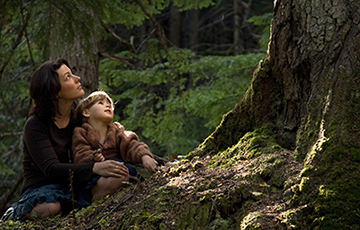 From The Diversity of Life, by the renowned expert in biodiversity, Professor Edward O. Wilson: “The green, prehuman earth is the mystery we were chosen to solve, a guide to the birthplace of our spirit, but it is slipping away … Humanity co-evolved with the rest of life on this particular planet; other worlds are not in our genes … it is reckless to suppose that biodiversity can be diminished indefinitely without threatening humanity itself. Signals abound that the loss of life’s diversity endangers not just the body but the spirit. We should judge every scrap of biodiversity as priceless while we come to understand what it means to humanity. An enduring environmental ethic will aim to preserve not only the health and freedom of our species, but access to the world in which the human spirit was born.”
From The Diversity of Life, by the renowned expert in biodiversity, Professor Edward O. Wilson: “The green, prehuman earth is the mystery we were chosen to solve, a guide to the birthplace of our spirit, but it is slipping away … Humanity co-evolved with the rest of life on this particular planet; other worlds are not in our genes … it is reckless to suppose that biodiversity can be diminished indefinitely without threatening humanity itself. Signals abound that the loss of life’s diversity endangers not just the body but the spirit. We should judge every scrap of biodiversity as priceless while we come to understand what it means to humanity. An enduring environmental ethic will aim to preserve not only the health and freedom of our species, but access to the world in which the human spirit was born.”
To make this a reality requires a struggle against huge political forces, which requires both heart and mind: essentially, a combination of passion and science. Two decades ago, the Valhalla Wilderness Society, in a partnership between science and conservation, began sponsoring biodiversity research in the Inland Rainforest, hosting experts in various fields from a number of countries, who volunteered a large part of their labour; some are still doing so today.
Basic Ecology of Inland Temperate Rainforest

|
Inland Temperate Rainforest is Interior Cedar-Hemlock (ICH) forest. The old-growth (“climax”) forest is dominated by Western Redcedar and Western Hemlock. ICH has been divided into dry, moist, wet or very wet types. Only the wet and very wet types are Inland Temperate Rainforest. The dark green on the map is the Valhalla Wilderness Society’s project area, where we commissioned a massive computerized forest cover mapping project by Applied Conservation GIS. This area is more commonly called the Interior Wetbelt, and has the majority of the ICH in BC. Only the northern two-thirds of this region have the wet and very wet type of forest. However, the moist and dry forms in the southern third were rainforest at some time after the Ice Age glaciers receded. This area has remnant groves of huge trees, but only in particularly wet places not subject to forest fires. The glaciers also left remnant rainforest species found all the way south into Idaho. These humid and dry types of cedar-hemlock forest are warmer and have their own ecology, including their own species-at-risk not found further north. |
|
The Inland Rainforest Region covers 14.3 million hectares, but only 65% of it is forestland. Most of the rest is high mountain terrain, with alpine meadows, rock and ice. There is also high-elevation spruce-balsam forest, which has much less biodiversity than the cedar-hemlock. Only 15% of the forest in the region is Inland Temperate Rainforest. Only about 5.1% of the forestland is intact old-growth cedar-hemlock. Only 3.2% is low-elevation intact old-growth cedar-hemlock. The valley-bottom forest has by far the highest biodiversity, but by far the least protection. |
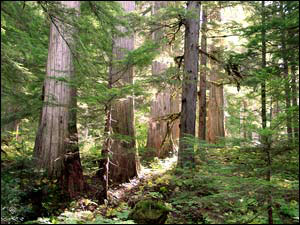 |
|
The Incomappleux Valley In the Incomappleux River Valley, kilometre after kilometre of ancient forest was leveled to the ground by chainsaws before many people knew what was there. The remnant third of the valley was found to be the largest intact body of truly primeval Inland Temperate Rainforest known to exist. It stands today as likely the most beautiful forest in interior BC, with an as-yet pristine, glacier-blue river running through it. It is used by grizzly bears. Research sponsored by the Valhalla Wilderness Society, and carried by a team led by biologist Toby Spribille, found nearly 300 species of lichens in the valley, mostly in the old-growth, with 7 species identified as new to science. Using this science, the logging was then stopped, first by environmental groups and independent activists, and then by expensive damage done to the road by slides. According to Dr. Spribille: “Further fragmentation of this forest would represent a direct and immediate threat to many species whose distribution is limited to short distances, and for which a clearcut represents an immense migration barrier. Fragmentation would create canopy gaps allowing valley winds to penetrate into the heart of forest canopies that have been sheltered and humid for over a thousand years. This would dry out the habitats of species, such as the COSEWIC-listed Species of Concern Nephroma occultum, whose existence depends on very stable humidity and constant, undisturbed conditions.” However, there are five approved cutblocks in the midst of some of the oldest trees and the highest concentration of rare species. A logging company need only to decide to fix the road, and in BC, these trees could be logged before the public knows anything about it. |
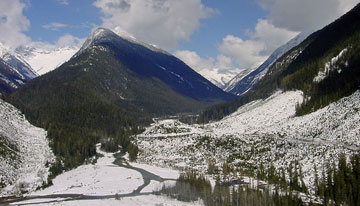 |
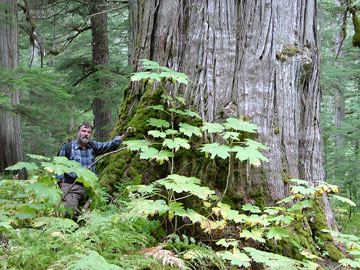 |
Biodiversity Research in the Incomappleux Valley
|
 |
 |
 |
|
Scientists discover numerous species new to science in BC’s endangered Inland Temperate Rainforest Research, sponsored partially by the Valhalla Wilderness Society, has shown that BC’s Inland Rainforest has one of the richest tree-dwelling lichen floras in the world. Imagine a forest in which the trees and rocks are encrusted and draped with literally hundreds of species of elven lichens. Some are inconspicuous and homely, some suggest an exquisite miniature kingdom fit for fairy tales, others are large, disorderly and luxuriant on the limbs of trees. They are the product of hundreds, perhaps thousands of years of stable growing conditions in the old-growth forest. Many species indicates many functions in the working of the forest ecosystem, and many linkages with other forms of life. Some lichens, like the leafy Lung Lichens (top, left), are natural fertilizers, aiding the growth of trees by capturing nitrogen from the air. The temperate rainforests are poor in nitrogen. Lichens can provide up to half the nitrogen requirement of a forest. Throughout the world, healthy lichen vegetation has come to stand for a healthy environment. Many species of wildlife depend upon lichens for food and nesting materials. Mountain caribou are totally dependent upon hair lichens (above, centre), for their winter food. Some moths have a special relationship with lichens. In its caterpillar stage, the Lichen Moth feeds on lichens. Lichens make unusual chemicals and little is known about their role in the ecosystem. Some moths sequester these compounds, making them taste bad to predators. Their vivid colour may be a warning that they are not good to eat. Other species, such as the mosses or the insects, have never been studied intensively over a broad area in the inland rainforest. We don’t know what we are losing as logging moves ahead. |
 |
 |
|
 |
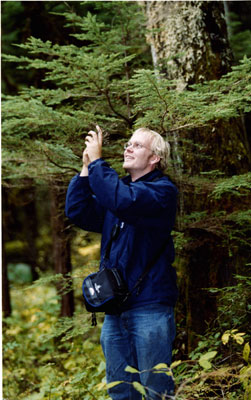 |
Science in the Making: Biology student Toby Spribille (now Dr. Spribille) did the first, brief botanical survey of the area. His findings played a key role in stopping the logging of the Incomappleux; they also helped him bring biologists from other fields and other countries to the Incomappleux. He and Curtis Bjork (left) have identified 13 species of lichens new to science in the Inland Temperate Rainforest. Nine of these were found by Spribille in the Incomappleux. Many others, though typical of Coastal Temperate Rainforest, had never before been found inland. In some cases they were new to BC, or even new to Canada. In the Incomappleux alone, Spribille found 283 lichen species, of which 213 grow on trees, including nine of the 13 species new to science. “Such levels of lichen diversity and rates of discovery of new species are basically unparalleled in northern conifer forests,” he explains. “We are definitely looking at a major center of lichen diversity at a global level that we haven’t even begun to fathom or explain.” He expects that further research would turn up many more species new to science. Together, the researchers are currently looking at over 40 candidate new species, pending further studies. About 90% of the nearly 300 lichen species found by Spribille were found in the old-growth forest. “Every valley has a unique set of species that reflects its special environment and history,” says Spribille. “Those growing in old-growth forest have likely grown in the humid canopies of trees for hundreds of years. We know almost nothing of how these species spread, but repeated experience has shown that they are not found in second growth forest.” North of the Incomappleux, in the Cariboo Mountains and the North Thompson and Robson Valleys, there is much more intact inland rainforest, but it has been little studied. There could be other Incomappleux Valleys unknown to science threatened by the chainsaw. Below, left: Brand new to science, lichen Pertusaria diluta is grayish green with pink fruiting bodies. Each fruiting body is about 0.03 millimeters wide. |
 |
 |
 |
 |
|
Mushrooms, Rare Plants, and Species at Risk BC’s Conservation Data Centre (CDC) lists 196 species-at-risk (red- and blue-listed) in the Interior Cedar-Hemlock (ICH) biogeoclimatic zone. In 2003 the Valhalla Wilderness Society forest technician, Craig Pettitt, accompanied a team of botanical specialists on a trip to the Incomappleux. Dr. Oldriska Ceska (above, centre) found the rare Phaeocollybia piceae (above, right), a mushroom previously associated only with very old coastal rainforest. One of the few places this mushroom has ever been found is in the rainforest of Olympic National Park. Sixty-two other mushroom species were found in the old-growth, including 22 species that grow in coastal temperate rainforest. In one brief foray into a wetland in the Inland Rainforest, Dr. Adolf Ceska (right), a botanical consultant formerly with the CDC, found the red-listed (endangered) pale bladderwort (Utricularia ochroleuca) and Toby Spribille found one of BC’s rarest orchids, the red-listed Liparis loeselii (right, bottom). It is only the fourth, and by far the largest, population ever found in BC. Spribille also found the uncommon Asplenium fern (below, centre) on a wet rock outcropping. Botanical consultant Dr. Adolf Ceska (upper right), formerly with the Conservation Data Centre, witnessed these discoveries and confirmed the identifications of the plants. Viktoria Wagner (directly right), a student at the University of Göttingen, Germany, began surveying the mosses. She found a blue-listed moss, Hookeria lucens, formerly associated only with coastal rainforest. In the summer of 2006, she returned to study the plants of the subalpine meadows in the Inland Rainforest region. Since that survey, more species of rare or endangered plants continue to be found in the Incomappleux, such as the red-listed mountain moonwort (Botrychium montanum). It takes a long time to determine whether species meet the criteria for being listed; there is a long backlog of candidate species, and with the poor state of knowledge on many species, it is certain that many are at risk without being listed. But further, the recent discovery of 13 new lichen species, with another 40 candidate species for being “new to science”, shows that we do not even know completely what’s there, much less whether it’s at risk. It must be stressed that all the species of lichens, plants and fungi shown on this website were found with only cursory examination of a few small areas in the Inland Temperate Rainforest.
|
 |
||
 |
|||
 |
|||
 |

